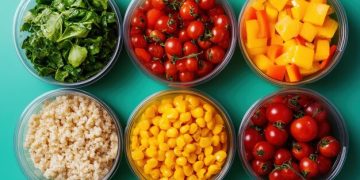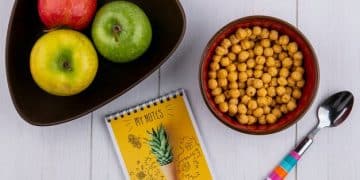Master Weekly Meal Prep for Healthy Eating Success
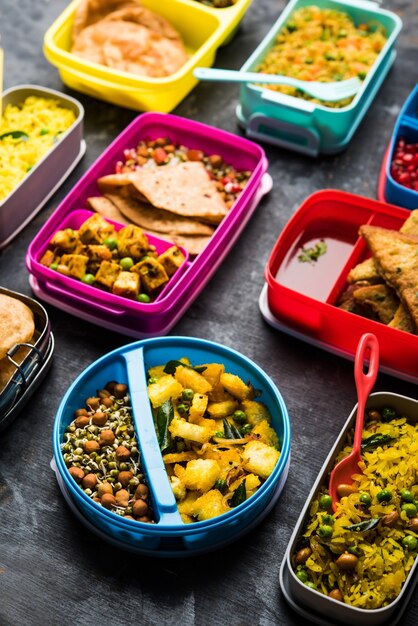
Mastering weekly meal preparation is a strategic and efficient approach to maintaining a consistent, healthy eating regimen, saving time, money, and reducing stress by having nutritious meals readily available.
Embarking on a journey towards consistent healthy eating often feels daunting, but what if there was a simple, yet profoundly effective strategy to streamline your dietary goals? Enter The Complete Guide to Meal Prepping for a Week of Healthy Eating, a practice that transforms good intentions into tangible, delicious, and sustainable habits. This comprehensive guide aims to demystify meal prepping, empowering you to take control of your nutrition one organized, flavorful meal at a time.
Understanding the Core Principles of Meal Prepping
Meal prepping is more than just cooking in bulk; it’s a strategic approach to food management that redefines your relationship with eating. At its heart, meal prepping involves planning and preparing meals and snacks in advance, typically for an entire week. This forward-thinking method stands in stark contrast to daily, last-minute cooking decisions, which often lead to less healthy choices, increased food waste, and unnecessary stress.
The journey begins not in the kitchen, but on paper or a digital device, with a meticulously crafted meal plan. This foundational step dictates what you’ll eat, helping you visualize your nutritional intake and categorize necessary ingredients. From there, the process unfolds into a series of systematic steps: shopping, cooking, portioning, and storing. Each stage is designed to maximize efficiency and minimize effort during your busy week, ensuring that healthy options are always within arm’s reach.
Benefits Beyond the Plate
While the immediate advantage of meal prepping is having healthy food readily available, its benefits permeate various aspects of life. It’s a powerful tool for financial management, significantly reducing impulse purchases and expensive takeout meals. For those dedicated to fitness, meal prepping offers unparalleled control over macronutrient intake, crucial for achieving specific body composition goals. Furthermore, it liberates valuable time during the week, allowing for more leisure, exercise, or simply relaxation after a long day.
- 📈 **Cost Savings:** Cuts down on expensive restaurant meals and impulse grocery buys.
- ⏰ **Time Efficiency:** Frees up significant time during busy weekdays.
- 🍎 **Nutritional Control:** Ensures consistent healthy eating and precise macronutrient tracking.
- 🗑️ **Reduced Food Waste:** Utilizes ingredients fully, minimizing spoilage.
Beyond the tangible benefits, meal prepping cultivates a sense of discipline and mindfulness around eating. It encourages a deeper understanding of food and nutrition, fostering a proactive rather than reactive approach to your diet. This shift can lead to profound long-term health improvements and a more balanced lifestyle.
Strategic Planning: The Blueprint for Your Week
The success of your meal prep journey hinges on meticulous planning. This phase is your opportunity to outline your nutritional goals, accommodate dietary preferences or restrictions, and build a diverse menu that keeps boredom at bay. Starting with a clear vision prevents mid-week culinary fatigue and ensures you stay committed to your healthy eating objectives.
Consider your personal schedule and energy levels. Some days might require quick, grab-and-go options, while others allow for more elaborate, but still prepped, meals. Incorporating a variety of proteins, complex carbohydrates, and vibrant vegetables is key to a balanced diet and sustained energy. Don’t be afraid to experiment with different cuisines and flavors to keep things exciting.
Crafting Your Weekly Menu
Before you even think about setting foot in a grocery store, dedicate time to creating your menu. This should span all meals: breakfast, lunch, dinner, and any snacks you plan to consume. Think about how ingredients can be cross-utilized to reduce waste and maximize efficiency. For instance, roasted chicken prepared for dinner can transform into a salad topping for lunch the next day.
- 🍳 **Breakfast Ideas:** Overnight oats, hard-boiled eggs, pre-portioned smoothie ingredients.
- 🥗 **Lunch Ideas:** Grain bowls, large salads with pre-cooked proteins, soup portions.
- 🍽️ **Dinner Ideas:** Baked chicken and roasted veggies, chili, stir-fry components.
- 🍎 **Snack Ideas:** Chopped fruits and vegetables, portioned nuts, hummus with whole-grain crackers.
Once your menu is set, create a detailed shopping list. Organize it by grocery store sections to make your trip as swift and efficient as possible. This step not only saves time but also prevents impulsive, unhealthy purchases. A well-constructed plan is your first line of defense against dietary derailment.
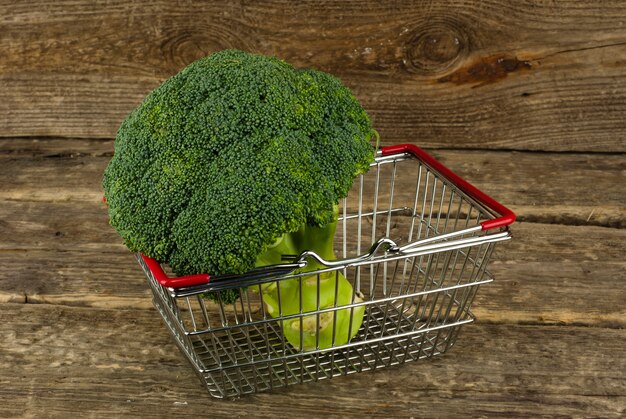
Essential Tools and Storage Solutions
Executing an efficient meal prep strategy requires more than just good intentions; it demands the right tools and proper storage. Investing in a few key kitchen gadgets and high-quality containers can dramatically streamline the process, ensuring your food stays fresh and safe to consume throughout the week. Think of these as your allies in the battle against unhealthy eating habits.
Start with the basics: sharp knives for efficient chopping, sturdy cutting boards, and reliable measuring cups and spoons. Beyond these fundamental items, consider appliances that can handle batch cooking, such as a large sheet pan for roasting multiple vegetables at once, or a slow cooker that allows for hands-off preparation of stews and chilis. These tools empower you to cook larger quantities with minimal effort.
Container Considerations
The type of containers you use is paramount for maintaining food quality and preventing spoilage. Airtight containers are a must, whether they are glass or BPA-free plastic. Glass containers are often preferred for their durability, non-porous nature (preventing lingering food smells), and ability to go from freezer to microwave or oven.
- 🧊 **Glass Containers:** Durable, oven/microwave safe, doesn’t retain odors.
- ♻️ **BPA-Free Plastic Containers:** Lightweight, more affordable, good for portability.
- 📏 **Sectioned Containers:** Perfect for keeping components of a meal separate until serving.
- ❄️ **Freezer-Safe Bags:** Ideal for storing larger portions or freezing individual ingredients.
Remember to consider portion control when selecting containers. Having containers that hold the exact amount of food for one meal makes portioning a breeze and helps prevent overeating. Properly labeling your containers with the date and meal type is also a simple but effective habit that enhances food safety and organization.
Batch Cooking Techniques and Strategies
Batch cooking is the heart of meal prepping. This is where you transform your carefully planned menu and gathered ingredients into ready-to-eat meals. The goal is to maximize efficiency, minimize cooking time خلال the week, and create diverse components that can be mixed and matched to form various meals.
Start by identifying ingredients that require the longest cooking times or can be used across multiple dishes. Grains like quinoa or brown rice, for example, can be cooked in a large batch and then portioned for different meals. Similarly, roasting a large tray of vegetables or baking several chicken breasts simultaneously can serve as the foundation for numerous healthy meals throughout your week.
Optimizing Your Cooking Flow
To make your batch cooking session enjoyable and productive, consider creating a cooking timeline. Begin with tasks that require passive cooking time, such as baking potatoes or simmering stews. While these are cooking, move on to active tasks like chopping vegetables or preparing marinades. This multi-tasking approach ensures you’re always working towards your goal without feeling overwhelmed.
- 🥦 **Prep Vegetables First:** Wash, chop, and store all vegetables before cooking anything.
- 🍚 **Cook Grains in Bulk:** Prepare a large batch of quinoa, rice, or couscous.
- 🍗 **Batch Cook Proteins:** Bake or grill a large quantity of chicken, fish, or tofu.
- 🍲 **Prepare Sauces/Dressings:** Make dressings and sauces in advance for easy assembly.
Don’t be afraid to partially cook ingredients. For example, you might sauté onions and peppers, but leave them slightly undercooked so they finish cooking when reheated later in the week. This preserves texture and flavor. Remember, the ultimate goal is efficiency without sacrificing the quality or taste of your meals.
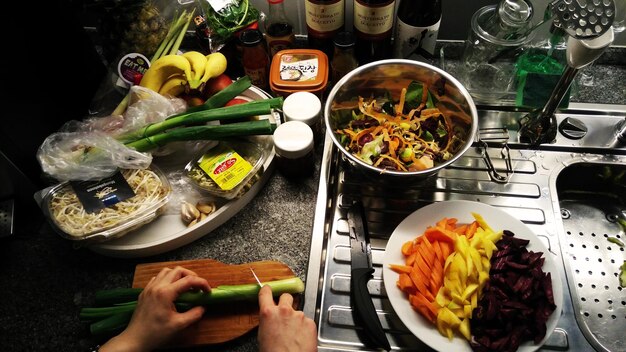
Maintaining Freshness and Food Safety
Once your delicious meals are prepped, the next critical step is ensuring they remain fresh, safe, and appetizing for the entire week. Proper storage is not just about convenience; it’s fundamental to food safety and the ultimate enjoyment of your prepped dishes. Neglecting this crucial phase can negate all your hard work and potentially lead to foodborne illnesses.
The golden rule for food safety is the “two-hour rule”: perishable foods should not be left at room temperature for more than two hours. After cooking, cool down your food quickly by dividing it into smaller portions and placing containers in an ice bath or shallow cold water. Once cooled, food should be promptly refrigerated or frozen.
Storage Best Practices
Each type of food has its ideal storage conditions. Cooked proteins, grains, and most cooked vegetables will last safely in the refrigerator for 3-4 days. If you’re prepping for a full week, consider freezing some portions, especially for meals intended for the latter half of the week. Labeling containers with the date they were prepared is an indispensable habit.
- 🌡️ **Refrigerate Promptly:** Within two hours of cooking, cool and refrigerate food.
- 🗓️ **Observe Shelf Life:** Cooked meals typically last 3-4 days in the fridge.
- 凍 **Utilize Freezing:** For longer storage (weeks to months), freeze individual portions.
- ✍️ **Label Everything:** Date and name all containers for easy tracking.
Remember to store different food components separately if possible, especially if their shelf lives vary. For instance, dressing for salads should be kept separate until just before serving to prevent soggy greens. When reheating, always ensure food reaches an internal temperature of 165°F (74°C) to kill any potential bacteria. Proper handling and storage are the final, vital steps in a successful meal prepping routine.
Beyond the Basics: Advanced Meal Prep Tips and Customization
Once you’ve mastered the fundamentals of meal prepping, it’s time to elevate your routine. Advanced meal prepping isn’t about more complex recipes, but rather about refining your process, expanding your culinary repertoire, and truly customizing your prep to fit your evolving needs and preferences. This phase is where meal prepping transforms from a chore into a truly enjoyable and sustainable lifestyle.
One key aspect of advanced meal prep is thinking in “components” rather than “full meals.” Instead of prepping entire dishes, prepare versatile building blocks: a large batch of grilled chicken, several types of roasted vegetables, various grains, and a few homemade dressings. This approach offers unparalleled flexibility during the week, allowing you to quickly assemble different meals based on your cravings or schedule.
Customizing for Dietary Needs and Preferences
Meal prepping is highly adaptable to various dietary requirements. Whether you’re vegetarian, vegan, gluten-free, or managing specific allergies, the principles remain the same: plan, prepare, and store. The focus shifts to selecting appropriate ingredients and ensuring cross-contamination is avoided when cooking for varied dietary needs within one household.
- 🌱 **Plant-Based Prep:** Focus on legumes, tofu, tempeh, and a wide array of vegetables.
- 🚫 **Allergy-Friendly:** Always check ingredient labels and use separate cutting boards/utensils.
- 💪 **Fitness Goals:** Adjust macronutrient ratios for muscle gain, weight loss, or maintenance.
- 🌍 **Cultural Cuisine:** Explore diverse recipes to keep meals exciting and flavorful.
Beyond dietary needs, advanced meal prepping involves continuous learning and adaptation. Experiment with new recipes, kitchen gadgets, and storage methods. Don’t be afraid to iterate on your process; what works one week might need tweaking the next. The beauty of meal prepping lies in its flexibility and its capacity to grow with you on your healthy eating journey. It’s truly a skill that gets better with practice, leading to greater culinary confidence and a healthier you.
| Key Aspect | Brief Description |
|---|---|
| ✅ Planning Ahead | Crucial for optimizing time and avoiding unhealthy choices. |
| 🍽️ Proper Storage | Ensures food safety and extended freshness throughout the week. |
| ⚡ Batch Cooking | Efficiently prepares multiple meal components in one session. |
| 💡 Flexibility | Adapt methods and recipes to suit personal dietary needs and lifestyle. |
Frequently Asked Questions About Meal Prepping
Most cooked and properly stored meal-prepped foods, such as chicken, cooked grains, and roasted vegetables, will remain fresh and safe to eat for three to four days in the refrigerator. Some items, like salads with dressing, might have a shorter shelf life, emphasizing the importance of separate storage for components.
Airtight containers made of glass or BPA-free plastic are ideal. Glass containers are particularly recommended because they are durable, microwave and oven safe, and do not retain food odors or stains. Look for containers that are stackable and offer good portion control, fitting your specific dietary needs.
While prepping for an entire week is possible, many find that prepping for 3-4 days at a time yields fresher and more appetizing meals. For a full week, consider freezing portions for the latter part of the week or focusing on meals that freeze well, like stews and chilis, and planning separate light prep for the last few days.
Common mistakes include not planning properly, cooking too much of the same food leading to boredom, not considering food safety practices, and neglecting proper cooling and storage. Overlooking variety can lead to giving up, so embracing diverse flavors and textures is key to long-term success in meal prepping.
Though often associated with weight loss due to better portion and calorie control, meal prepping serves many other purposes. It’s excellent for saving money, reducing food waste, saving time during busy weekdays, and ensuring consistent healthy eating for overall well-being, regardless of specific weight goals.
Conclusion
As we’ve explored throughout, meal prepping is far more than a fleeting trend; it’s a powerful, sustainable strategy for enhancing your health, managing your time, and controlling your finances. From the strategic planning that lays the groundwork for delicious and nutritious meals to the critical aspects of food safety and advanced customization, each step in this comprehensive guide is designed to empower you. Embracing meal prepping for a week of healthy eating is an investment in yourself, promising not just a plate of wholesome food, but a lifestyle marked by greater efficiency, mindful choices, and unwavering commitment to your well-being. Start small, be consistent, and watch as your relationship with food transforms, one perfectly prepped meal at a time.
